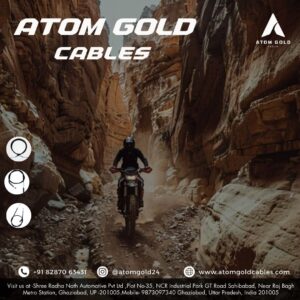When it comes to vehicle performance, the relationship between cable length vs. performance is often overlooked. However, selecting the right cable length plays a crucial role in ensuring smooth, responsive vehicle operation. Whether you’re operating a two-wheeler, four-wheeler, or even heavy-duty machinery, the correct cable length ensures that systems like the throttle, brake, and clutch function optimally. This article will explore how cable length impacts performance and how to find the right balance to maximize vehicle efficiency and safety.

Whether you’re riding a two-wheeler, driving a four-wheeler, or operating heavy-duty machinery, the importance of choosing the right cable length cannot be overstated. Too short or too long a cable can negatively affect how smoothly the vehicle operates, potentially leading to increased wear, mechanical failure, and a diminished driving experience. This article will delve into the relationship between cable length and vehicle performance, and explore how to find the perfect balance to maximize functionality and safety.
The Role of Control Cables in Vehicles:
Control cables are responsible for transmitting mechanical force to engage or disengage various systems within a vehicle. From accelerator cables to brake cables, clutch cables, and choke cables, these components serve as the intermediary between the driver’s input and the vehicle’s mechanical response.
For instance, when you press the clutch pedal in a motorcycle, the clutch cable transmits the force, engaging or disengaging the engine from the transmission. Similarly, the throttle cable controls the speed of the vehicle by regulating the fuel intake. The brake cables ensure that the vehicle slows down or stops when you apply pressure to the brake pedal or lever.
Each of these systems requires precise control to operate effectively. This is where cable length comes into play.
Understanding the Impact of Cable Length on Vehicle Performance:
The length of a cable can influence its efficiency in several ways. Whether it’s too long, too short, or just right, the cable length affects how well the system responds to the driver’s actions. Let’s take a closer look at how cable length can impact vehicle performance:
1. Too Short a Cable:
Impact on Performance: When the cable is too short, it can cause excessive tension within the system. This tension makes it harder to engage or disengage the system (e.g., clutch or throttle). For example, a short clutch cable can make it difficult to fully disengage the clutch, which could result in poor shifting or slipping. Similarly, a brake cable that is too short may lead to incomplete brake engagement, compromising safety and effectiveness.
Increased Friction and Wear: Short cables tend to create more friction within the system due to the additional tension. This increases wear on both the cable and the components it’s connected to. Over time, this can lead to faster degradation and, eventually, failure of the cable or its associated systems. A short cable also increases the risk of breaking, especially if the cable is subject to extreme conditions such as high temperatures, moisture, or dirt.
Safety Concerns: A cable that’s too short can negatively affect a vehicle’s safety. For example, in the case of brake cables, if the cable is too short, it could lead to a delayed braking response, compromising the driver’s ability to stop the vehicle quickly. Similarly, throttle cables that are too short may cause erratic engine responses, which can result in loss of control.
2. Too Long a Cable:
Impact on Performance: On the other hand, using a cable that is too long introduces its own set of issues. A longer cable can introduce slack, making it harder for the driver to control the system with precision. For instance, a long throttle cable may cause the throttle to engage more slowly, reducing the vehicle’s acceleration response time. Similarly, a long clutch cable can create a delay when engaging or disengaging the clutch, making shifting gears less smooth and reducing overall vehicle performance.
Slower Response Time: A cable that is too long often results in an imprecise operation. The excess length allows the cable to “stretch” between the components, leading to slower response times. When the driver pushes or pulls on the control, the system takes longer to react because the cable needs more time to travel through the system. This lack of responsiveness can be frustrating, especially in performance-driven vehicles.
Increased Risk of Damage: Longer cables are also more prone to tangling, especially in tight spaces. This can cause unnecessary friction and reduce the longevity of the cable. The extra slack may also rub against other parts of the vehicle, potentially causing abrasion or damage to both the cable and surrounding components.
3. The Right Cable Length:
The key to optimal vehicle performance lies in finding the right balance between cable length and the system’s requirements. The correct length ensures that the cable operates under the appropriate tension, providing quick and precise control, without introducing excessive slack or strain.
Precision and Responsiveness: With the correct cable length, you’ll notice a smooth and immediate response when you operate the vehicle’s control systems. The throttle will engage quickly, the clutch will disengage smoothly, and the brake will apply evenly. The right length ensures the system remains in tune with the driver’s inputs, resulting in improved vehicle handling and performance.
Durability and Longevity: The right cable length minimizes unnecessary friction and tension, reducing wear and extending the lifespan of the cable. This leads to fewer replacements and less maintenance. Additionally, properly-sized cables are less likely to experience damage, whether from friction, rubbing, or stretching. Thus, selecting the right length helps preserve the integrity of both the cable and the vehicle’s components.
Safety: Safety is paramount, and proper cable length plays a significant role in maintaining it. The right length ensures that the vehicle’s control systems respond quickly and accurately, reducing the risk of accidents due to delayed reactions or mechanical failures.
How to Choose the Right Cable Length:
Choosing the right cable length depends on several factors, including the type of vehicle and the specific system the cable controls. To ensure that you select the correct length, consider the following:
- Consult Manufacturer Specifications: Always refer to the manufacturer’s guidelines for the recommended cable length for your specific vehicle. These specifications ensure that the cable operates within the optimal range for performance and safety.
- Customization for Specific Vehicles: Some vehicles, particularly custom or modified ones, may require specialized cable lengths. Work with a professional technician who can accurately measure and adjust the cable length based on your vehicle’s needs.
- Quality of the Cable: Beyond the length, ensure the cable is made from high-quality materials that are durable and resistant to wear and tear. Opt for cables with smooth coatings or lubrication that reduce friction and improve performance.
Conclusion:
The relationship between cable length and vehicle performance is critical to ensuring smooth and safe operation. Whether you’re riding a two-wheeler, driving a four-wheeler, or using heavy machinery, getting the cable length right is essential for performance, durability, and safety. Too short or too long a cable can lead to increased friction, poor responsiveness, and premature wear. By finding the right balance, you ensure that the vehicle operates at its best, providing a seamless driving experience and reducing the likelihood of costly repairs.
Always prioritize proper cable length selection and maintenance, and work with professionals to ensure your vehicle’s control systems function at their peak.
Find the Atom Gold difference today – where the heritage of the past is merged with the technology of the future, and quality is the standard.
For more information about our products or to place an order, visit our website or contact us at our office in Ghaziabad, UP. Let us help you drive with confidence, powered by the best accelerator cables in the industry.
Visit us at -Shree Radha Nath Automotive Pvt Ltd , Plot No-35, NCR Industrial Park GT Road Sahibabad, Near Raj Bagh Metro Station, Ghaziabad, UP -201005. Mobile- 9873097340, 82870 63431 Ghaziabad, Uttar Pradesh, India 201005
